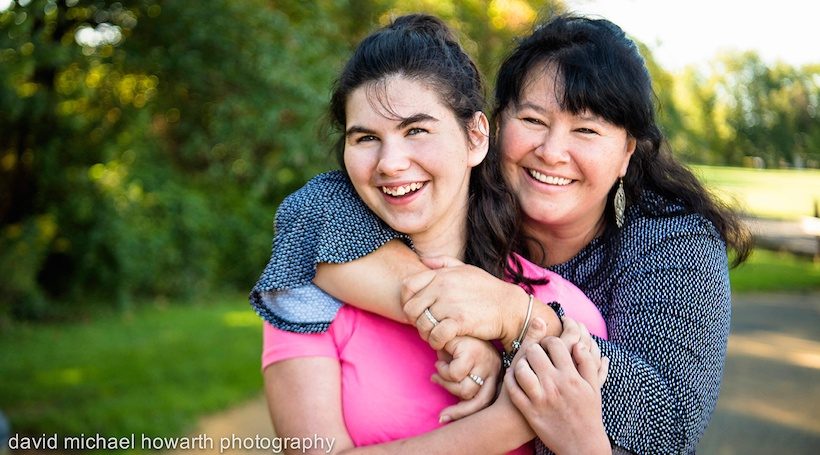As a baby, Korinne Sanville had trouble sitting up in the cart while her mother Michael picked out groceries. She was also late to take her first steps and say her first words.
None of it was particularly alarming; Korinne was still developing within the windows of time pediatricians deem appropriate for such milestones, but Michael Sanville already had three older daughters, so she had a feeling something wasn’t quite right.
“If I didn’t have other kids, I might not have noticed,” Sanville says. “But she was my fourth.”
“At first her doctors brushed my concerns off. They said, ‘Well, she’s fine, she’s still in the window, just at the end. She’s fine, she’s fine.’ We didn’t get formally evaluated for autism until she was 2 or 3 and getting ready to go into the public school preschool program. By that point she wasn’t just developmentally delayed, but intellectually delayed as well.”
By the time she entered preschool, Korinne, whose family lives in Voorhees, was diagnosed with autism. New research is finding that Korinne’s diagnosis might have come sooner, except for one thing: she’s a girl.
It’s estimated that autism spectrum disorder (ASD) affects one in 68 children in the United States, and a commonly reported statistic says ASD is four or even five times more common in boys. Genetic studies have shown a potential link between ASD and the X chromosome, and experts have long hypothesized that girls’ two X chromosomes offer some measure of protection against the disorder. Newer research suggests they may be wrong.
Donna Murray, PhD, head of clinical programs with Autism Speaks, says more doctors now think autism presents differently in girls, leading to a delayed diagnosis or a misdiagnosis.
“It’s an area of study that’s still emerging, and it requires much more research,” Murray says. “We’re not anywhere close to fully understanding how gender plays a role in autism. The question comes up: Is it really occurring more in boys, or are we in some way not effectively diagnosing girls? Right now it looks like it’s probably a little bit of both. We’re likely still looking at a ratio of 2:1 or even 3:1, but it’s certainly not as disproportionate as we once thought.”
There is no definitive blood or genetic test for ASD, and the diagnostic tools clinicians use were developed based on male patients.
“The diagnostic tests revolve around picking up on the most common characteristics of ASD,” Murray says. “They’ve been standardized on the male presentation of autism.”
There are two major characteristics doctors look for, says Wendy Aita, PhD, interim director of Rowan’s Center of Excellence for Mental Health Treatment of Persons with Intellectual Disabilities.
“We look for difficulty with social communication and interaction with others, and repetitive behavior that is rigid and inflexible,” Aita says. “In girls, those things are often far more subtle. A boy with repetitive behavior might be interested in knowing every single thing about dinosaurs or the weather or memorizing train schedules. Girls may have the same extreme interest in something, but because their interests tend to be more culturally acceptable or more stereotypical of what neurotypical girls are interested in, it goes unnoticed.”
Korinne is now 17, and Sanville says her repetitive behaviors aren’t always immediately apparent to strangers.
“When you see her, she looks totally normal,” Sanville says. “She can have a brief conversation. She loves shoes, and when she talks to a stranger she says, ‘Hi, I love your shoes. Where’d you get your shoes?’ Initially she can seem normal, but you realize after a while that you’re still talking about shoes.”
Aita says girls, especially before early adolescence, are often more capable of masking their difficulties in social situations.
“Girls tend to be able to camouflage their problems with mimicry,” she says.
“On a playground, a boy with autism tends to stay on the outskirts of the group. A girl with autism won’t engage in deep, meaningful-type communication, but she will engage. Girls tend to mimic social interaction, making eye contact and laughing at appropriate moments. It’s difficult to pick up on their social problems unless you’ve spent a considerable amount of time with them. In boys you can see it in 10 minutes. In girls it may take several hours.”
The subtlety of many girls’ symptoms means they go undiagnosed until they’re older, Aita says, thus missing out on early intervention.

Kaylee Bodine
Barry and Sharon Bodine, of Washington Township, went to a number of doctors and specialists before their daughter Kaylee was diagnosed with ASD.
“My wife knew something was up before I did – even before the doctors did,” Barry says. “When Kaylee was 3 or 4 they told us she was just taking a little bit longer to hit her milestones than most children. Sharon was adamant that there was a problem.”
“She’d get frustrated,” Sharon says. “She wasn’t babbling or saying words. She was banging her head on the wall and on the floor. She walked and crawled late. I’d look it up online and think, ‘Could this be autism?’ I didn’t even know what autism was before that.”
Despite being diagnosed too late for early intervention, Kaylee, now 10, was soon making strides in a program at Bancroft. The insight the Bodines gained was invaluable when it came to their younger daughter, Madeline.
“It’s rare to have one daughter on the spectrum, because usually it’s boys,” Barry says. “The doctors told us the odds of having two daughters on the spectrum is like hitting the lottery twice.”
Though Madeline, 8, and Kaylee both have ASD, they present with very different characteristics. Kaylee is non-verbal, but very social, Barry says.
“She’ll come right up to you, make eye contact and interact with you. Madeline is the opposite. She’s high-functioning, but she won’t look you in the eye, and her behavior with her peers is still atypical.”
Both girls are thriving with support from their doctors, schools and family.
“When we first got their diagnoses, it was half relief and half, ‘What now?’” Barry says.
“It’s always a process. Sometimes there’s a couple steps forward and a couple steps back, but we’ve been moving in the right direction. Our daughters are very happy and very healthy, and those are the two most important things to us.”
Aita says it’s vital for girls to receive diagnoses, early intervention and targeted therapies to help them navigate social situations into adulthood. As the research surrounding girls and autism continues to evolve, so do treatment strategies, and what works with boys is very different from what works with girls.
“Groups of neurotypical boys interact much differently than neurotypical girls. The protocols – just like the diagnostics – are designed for boys. What we’re doing now is working to expand the protocols and treatment options that will actually help girls with ASD.”
“As girls with ASD get older, they tend to be more ostracized, because girls are all about friendship and social interactions,” Aita says.
“Girls with ASD miss out on the chattiness and understanding the hierarchy in relationships. Girls are all about social status, and girls with ASD miss that. They tend to be more blunt in interactions and say things that neurotypical girls understand aren’t appropriate to talk about. They know when they’ve done something wrong, they just don’t know what it is.”
Without guidance and the skills to handle the social demands of the teen years, girls with ASD are at increased risk for other issues.
“The rates of depression, anxiety and eating disorders are disproportionately higher,” Aita says.
“Girls who have ASD are still looking for friendship. They try to find out what the rules are, but the problem is the rules of girls’ social interactions are so complex, and they constantly change. It leads to an increased sense of loneliness and failure, and we can avoid a lot of that with social skills training.”
Sanville says Korinne is a happy teenager; a small blessing after shepherding her other daughters, now 28, 27 and 24, through their teen years.
“Sometimes it’s like she’s 17, and sometimes it’s like she’s 6,” Sanville says.
“I know a lot of kids with autism have depression or anxiety. She has a friend who deals with that, because she knows she’s disabled. But Korinne doesn’t know she’s disabled, and we build up her self-esteem. She’s sweet and animated and funny and quirky. She’s the glue that keeps us all together.”














